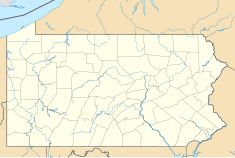Tunkhannock Creek Viaduct | |
|---|---|
 A Steamtown National Historic Site excursion train crosses Tunkhannock Viaduct. | |
| Coordinates | 41°37′20″N 75°46′38″W / 41.6222°N 75.7773°W |
| Carries | railroad traffic |
| Crosses | Tunkhannock Creek |
| Locale | Nicholson, Pennsylvania, U.S. |
| Characteristics | |
| Design | Deck arch bridge |
| Material | Concrete |
| Total length | 2,375 feet (723.9 m) |
| Longest span | 180 feet (54.9 m) each span |
| No. of spans | 10 (11 piers) |
| Clearance below | 240 feet (73.2 m) |
| Rail characteristics | |
| No. of tracks | 2 |
| Track gauge | 4 ft 8+1⁄2 in (1,435 mm) standard gauge |
| Structure gauge | AAR for the width only overhead open or clear |
| History | |
| Designer | Abraham Burton Cohen |
| Construction start | May 1912 |
| Opened | November 6, 1915 |
Tunkhannock Creek Viaduct | |
| Coordinates | 41°37′20″N 75°46′38″W / 41.6222°N 75.7773°W |
| Area | 3 acres (1.2 ha) |
| Built | 1912-1915 |
| NRHP reference No. | 77001203[1] |
| Significant dates | |
| Added to NRHP | April 11, 1977 |
| Designated PHMC | September 16, 1995[2] |
| Location | |
 | |
Tunkhannock Creek Viaduct (also known as the Nicholson Bridge and the Tunkhannock Viaduct) is a concrete deck arch bridge on the Nicholson Cutoff rail line segment of the Norfolk Southern Railway Sunbury Line that spans Tunkhannock Creek in Nicholson, Pennsylvania. Measuring 2,375 feet (724 m) long and towering 240 feet (73.15 m) when measured from the creek bed (300 feet (91.44 m) from bedrock), it was the largest concrete structure in the world when completed in 1915[3] and still merited "the title of largest concrete bridge in America, if not the world" 50 years later.[4]
Built by the Delaware, Lackawanna and Western Railroad (DL&W), the bridge is owned today by Norfolk Southern Railway and is used daily for regular through freight service.[5]
The DL&W built the viaduct as part of its 39.6-mile (63.7 km) Nicholson Cutoff, which replaced a winding and hilly section of the route between Scranton, Pennsylvania, and Binghamton, New York, saving 3.6 miles (5.8 km), 21 minutes of passenger train time, and one hour of freight train time. The bridge was designed by the DL&W's Abraham Burton Cohen;[6] other key DL&W staff were G. J. Ray, chief engineer; F. L. Wheaton, engineer of construction; and C. W. Simpson, resident engineer in charge of the construction. The contractor was Flickwir & Bush, including general manager F. M. Talbot and superintendent W. C. Ritner.[7]
In 1975, the American Society of Civil Engineers or ASCE designated the bridge as a National Historic Civil Engineering Landmark. ASCE noted that at the time of its construction from 1912 to 1915, it was the largest reinforced concrete railroad bridge ever built.
The bridge was also listed on the National Register of Historic Places on May 3, 1977.[8][9] In 1990, the National Railway Historical Society placed a historical plaque on the structure noting its size as the world's largest concrete bridge, completing the Summit cut-off project for the Delaware, Lackawanna and Western Railroad.
- ^ "National Register Information System – (#77001203)". National Register of Historic Places. National Park Service. July 9, 2010.
- ^ "PHMC Historical Markers". Historical Marker Database. Pennsylvania Historical & Museum Commission. Retrieved December 20, 2013.
- ^ "Twelve Million Dollars for Twenty Minutes Train Time". Popular Science Monthly. New York : D. Appleton. 1916. p. 7. Retrieved August 7, 2014.
- ^ Jackson, Donald C.; Yearby, Jean P. (1968). "Erie-Lackawanna Railroad, Tunkhannock Viaduct, Nicholson, Wyoming County, PA". Historic American Engineering Record. Washington, D.C.: Library of Congress. p. 1. Retrieved November 29, 2014.
- ^ Norfolk Southern completes acquisition of Delaware & Hudson South Line, PRNewswire, September 18, 2015
- ^ "The Nicholson Bridge".
- ^ Cite error: The named reference
simpsonwas invoked but never defined (see the help page). - ^ FEDERAL REGISTER, VOL 42, NO. 85-TUESDAY, MAY 3, 1977, page 22411.
- ^ Anon. "NRHP assessment for Tunkhannock". National Archives at College Park - Electronic Records (RDE). Department of the Interior. National Park Service. Retrieved 10 September 2019.

